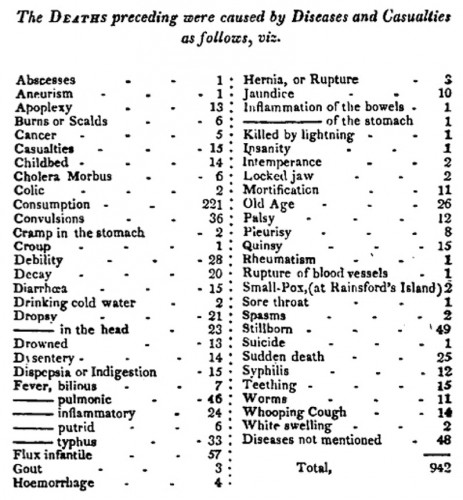Posted by Vale
Back in 1812 in Boston it was consumption that was most likely to kill you, although out of 942 recorded deaths, teething killed 15 and childbed 14, the same number that were killed by the quinsy.
In 1900 tuberculosis was near the top of the list, but pneumonia or influenza had overtaken it. A bad year for the flu?
By 2010 TB has disappeared, pneumonia languishes like a fading football team towards the bottom of the league buy cialis online aus table, while cancer has leapt to prominence.
From the three tables shown, it isn’t until 2010 that diabetes makes an appearance or suicide.
I’ve taken all the data from a fascinating article in the New England Journal of Medicine describing how, over 200 years, different diseases have come to the fore. More interesting are its reflections on the way that the different diseases that kill us are expressions of the society we live in.
Its worth a look.


Fascinating! How much cold water were those two people drinking?!
Dropsy, palsy, quinsy, croup. Tom Lehrer would have had fun with these historic killers. http://youtu.be/zGM-wSKFBpo
Ahem, there was one suicide in the 1812 table, there were probably lots but of course it was illegal and bad form and not a Christian thing to do certainly in the uk til 1961, so probably wasn’t going to be reported in medical stats.
http://www.bbc.co.uk/news/magazine-14374296
It’s really quite hard to sort out the stats from the stats and the society/ culture. 1812 one suicide per 942 deaths, 2010 12 per 100,000. Gone down then?
I’m going to stop saying ‘I was mortified’ after looking that cause up! And what was ‘white swelling’? I think I prefer the 1812 list somehow – I’ll probably die from insanity but I’d like to die in my sleep of one of the ‘diseases not mentioned’ – but not just yet!
I missed that early, solitary suicide. Somehow makes the lonely soul who topped themselves back in 1812 seem even more lonely. So perhaps the oddity is the lack of suicides in 1900.
Actually the whole is more for curiosity than for statistical meaning – there are charts for other years that would certainly contain earlier mentions of diabetes and suicides.
I like the earlier illnesses best too, Belinda. It’s like a heritage seed catalogue – there are so many more varieties available. Fevers for example. My favorite is in the article itself – where it notes the serious consideration given to the possibility of death ‘by the wind of a canonball’. Strongly attested it seems.
Vale, this reminds me of Eleanor Farjeon’s account of the death of Edward Thomas in WWI.
‘Edward’s Captain….told her that as Edward stood by his dugout lighting his pipe all the Germans had retreated, but a last shell they sent over passed so close to him that the blast of air stopped his heart. ‘He told me,’ Helen [his wife] writes, ‘there was no wound and his beloved body was not injured. This was borne out by the fact that when the contents of his pockets were returned to me – a bundle of letters, a note-book and the Shakespeare Sonnets I had given him, they were all strangely creased as though subject to some terrible pressure, most strange to see. There was no wound or disfigurement at all. He just died standing there in the early morning after the battle.”
I see you could still die of a fatal disease called ‘old age’ in those days, without breaking some law or medical code. Why can’t we do that any more? Is it because the medical profession likes to believe we have yet to reach a hypothetical limit to the extent of human life?
If so, what is it, I wonder, and why are they keeping so quiet about it?
Jonathan, ‘Old Age’ is a recognised cause of death on a medical certificate, without further qualification, but I believe doctors are encouraged to put additional supporting information if possible. You have to be of a certain age to achieve this single cause, however – and I haven’t registered a death for many a year, but I think that it currently stands at 80 plus.